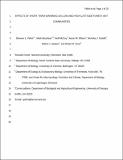Effects of Short-Term Warming On Low and High Latitude Forest Ant Communities
Author
Boudreau, Mark
McCoy, Neil
Gotelli, Nicholas J.
Sanders, Nathan J.
Dunn, Robert R.
Published Version
http://www.esajournals.org/loi/ecspMetadata
Show full item recordCitation
Pelini, Shannon L., Mark Boudreau, Neil McCoy, Aaron M. Ellison, Nicholas J. Gotelli, Nathan J. Sanders, and Robert R. Dunn. Forthcoming. Effects of short-term warming on low and high latitude forest ant communities. Ecosphere.Abstract
Climatic change is expected to have differential effects on ecological communities in different geographic areas. However, few studies have experimentally demonstrated the effects of warming on communities simultaneously at different locales. We manipulated air temperature with \(\textit{in situ}\) passive warming and cooling chambers and quantified effects of temperature on ant abundance, diversity, and foraging activities (predation, scavenging, seed dispersal, nectivory, granivory) in two deciduous forests at 35° and 43° N latitude in the eastern US. In the southern site, the most abundant species, \(\textit{Crematogaster lineolata}\), increased while species evenness, most ant foraging activities, and abundance of several other ant species declined with increasing temperature. In the northern site, species evenness was highest at intermediate temperatures, but no other metrics of diversity or foraging activity changed with temperature. Regardless of temperature, ant abundance and foraging activities at the northern site were several orders of magnitude lower than those in the southern site.Terms of Use
This article is made available under the terms and conditions applicable to Other Posted Material, as set forth at http://nrs.harvard.edu/urn-3:HUL.InstRepos:dash.current.terms-of-use#LAACitable link to this page
http://nrs.harvard.edu/urn-3:HUL.InstRepos:4892936
Collections
- FAS Scholarly Articles [18292]
Contact administrator regarding this item (to report mistakes or request changes)



